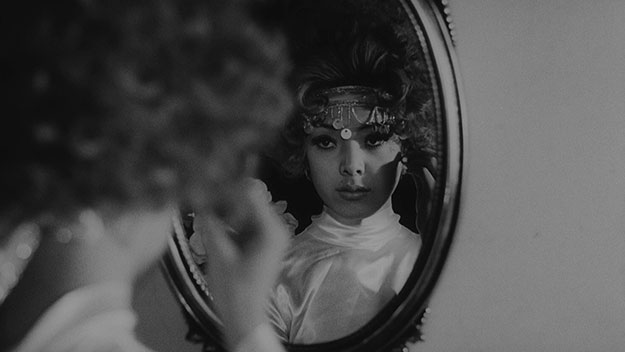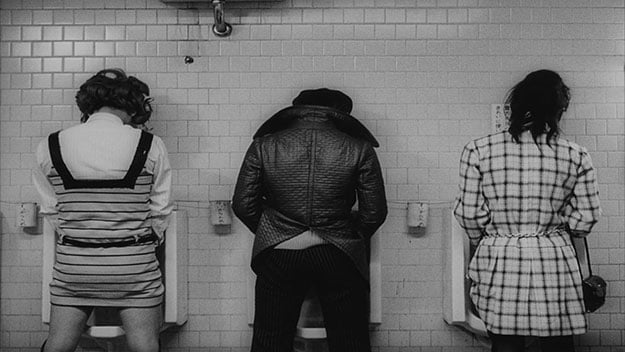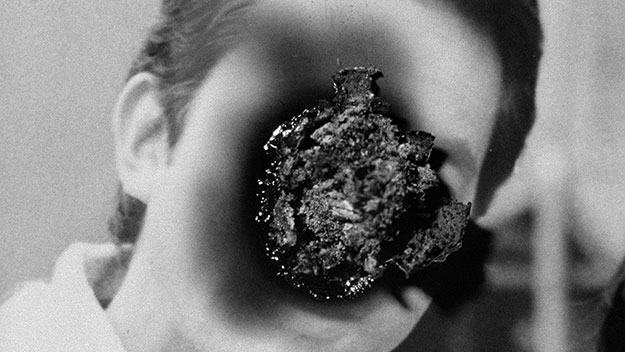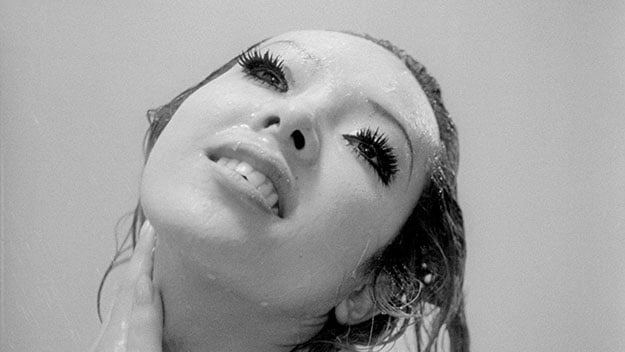Film of the Week: Funeral Parade of Roses

Toshio Matsumoto’s 1969 film Funeral Parade of Roses is a heady affair, especially when seen in our aesthetically and politically conservative times. It imparts the thrill of witnessing the hedonism and lawlessness—both sexual and artistic—of a bygone culture. You also feel an almost tragic surge of melancholia watching it: where and when, you wonder, will cinema ever get quite this wild again?
According to various online sources, Stanley Kubrick acknowledged Matsumoto’s film as an inspiration for A Clockwork Orange, although I haven’t found any concrete evidence for where or when he might have done so—and it’s hard to see exactly what he might have taken from Funeral Parade of Roses, other than a heavy use of wide-angle lenses and a general celebration of in-your-face provocation. Certainly, nothing in Kubrick’s work is remotely as queer as any given moment in Matsumoto’s feature.
Without giving too much away, Funeral Parade of Roses is partly a loose modern queer rewrite of the Oedipus myth, although how and why it is doesn’t fully become clear until the end—when we witness the supremely paradoxical use of a subjective shot depicting the point of view, as it were, of an Oedipus figure who has just gouged out both his eyes. For the most part, however, Funeral Parade comes across as a free-form evocation of an unofficial coalition between two outsider communities in Tokyo: on one side, cross-dressers and other young gay men (the Japanese term being geiboi), and on the other, avant-garde artists.

The film’s protagonist, at the center of a sort of Shinjuku demimonde reworking of All About Eve, is Eddie, a young transvestite nightclub hostess who is having an affair with the ostensibly straight, or at least straight-acting, club owner Gonda. Eddie is played by Peter, a singer and dancer whom you’ll know as the androgynous Fool character in Kurosawa’s 1985 King Lear adaptation Ran. Peter’s Eddie is drag star as ’60s It Girl, a baby-faced creature with big moon eyes under a blonde mop—Shinjuku’s own Edie Sedgwick. Peter charges the role with flirtatious wit and extreme sensuality—as witness the display of luxurious eye-rolling in a nude shower scene. As for Gonda, he is played by square-jawed, sports-jacketed Yoshio Tsuchiya, a mainstream and genre stalwart known for roles in various Kurosawa films including Seven Samurai and Throne of Blood—as well as Destroy All Monsters.
Gonda’s patronage will put Eddie in prime position to be the new madam of the Genet club, where middle-aged salarymen can make out with lissome cross-dressers; the Genet is currently ruled by the older Leda (Osamu Ogasawara), whose more traditional geisha guise contrasts with the go-go-girl look rocked by Eddie. The latter’s poisonous entanglement with Gonda and Leda itself makes for an Oedipal family schema, but the story also involves a more literal version of the triangle—the central mystery that the film’s jigsaw construction of repetitions and ellipses slowly circles in on, before getting to the nub of it in a violent flashback that is followed by an even more brutal pay-off revelation.
The other strand of the film involves an evocation of the artistic wild life of the late-’60s Shinjuku district. Eddie and his friends spend a lot of time hanging out with a group of hippie-ish marginals—a coalition of rebel subcultures that’s very Warholian. The artists’ group is led by young filmmaker Guevara (Toyosaburo Uchiyama), so named for his bushy mustache—which are revealed, in this pageant of self-exposing illusion and play-acting, to be as fake, as much a drag act, as anything else seen here. Guevara and company are making a film of some sort (it involves filming blurry, distorted TV coverage of student protests), and generally hanging out in a room, under the approving eyes of a Beatles poster, where they enjoy very late-’60s free-form freakouts. A stoned evening involves dancing wildly to fuzz-guitar jams (echoes of the Yardbirds in Antonioni’s Blow-Up), then a parlor game in which whoever can’t walk a straight line gets stripped by everyone else. This sequence goes on a long time, but everyone, actors and characters alike, seems to be having a groovy, guilt-free time—which is what makes the punitive Greek tragedy climax all the more unsettling.

Formally, Funeral Parade is an unpredictable, risk-drunk affair, mixing fiction (both quasi-realism and melodrama fabulism) with a deconstructive documentary edge, plus a carefree ludic goofiness that’s part Godard, part Three Stooges. Matsumoto and editor Toshie Iwasa undermine the narrative by dropping in interviews with various geiboi and stoners on their lifestyles—as well as one with Peter, who plays Eddie, on the very film we’re watching. A no-holds scene of anal sex between Eddie and an African-American john turns out to be only a matter of simulation—the lover is seen reclining at the opposite end of the bed to Eddie, with a crew headed by Matsumoto himself filming Peter’s solo exertions. Other interruptions include a flash insert of a warning from the Japanese board of film classification, plus—after the drama’s most emotionally extreme moment—a cut to an affable TV host inviting us to come back and enjoy another movie next week.
Elsewhere, the eventual confrontation between Eddie and Leda—flagged up in advance as the film’s dramatic boiling point—is played out as first a mock Western showdown with toy guns, then a duel of comic-strip word balloons, then as a farcically speeded-up catfight. Less playfully, the film is also laced with an array of quotes and slogans, both on and off screen: captions including (as they’re translated here) “What a Subtle and Mysterious Scheme,” “Oh The Empire of Roses,” and “The World Is About To End,” plus references to, among others, Jonas Mekas and French novelist J.M.G. Le Clézio.
There’s also a lot of street performance on show, largely the contribution of theater group Zero Jigen (Zero Dimension), known for their public interventions and more private orgiastic displays. Matsumoto believes in taking his spectacle to the streets—as in a scene in which Eddie and two friends rumble with three tough girls (members of a sukeban, or girl gang) in a shopping precinct, to the bewilderment of bystanders.

Funeral Parade was the first feature of Matsumoto, who had previously, for over a decade, made documentary and experimental shorts, and worked as part of interdisciplinary group Jikken-Kobo (Experimental Workshop)—one of whose members, the great composer Toru Takemitsu, collaborated on his films. The composer of Funeral Parade, also an eminent mainstay of Jikken-Kobo, is Joji Yuasa. His eerie electronic compositions set the tone at the start, as a setting for bleached-out close-ups of Eddie’s and Gonda’s love-making—this opening sequence surely a prime exhibit piece for an anthology of erotic modernism. The black-and-white photography by Tatsuo Suzuki (whose credits also include work with Shuji Terayama) throws in a wild array of textures and looks—including flash inserts of bleached-out photocopy stills, and a range of wide-angle interiors, both delirious and claustrophobic.
Funeral Parade of Roses is an extraordinary film for its energies, its libidinous intensity, and its fearlessness in mixing registers—high melodrama, violent intensity, farcicality, and poetic seriousness—all against a background of late-’60s aesthetic revolt and political unrest (notably the student protests against U.S. military presence in Japan during the Vietnam War). Film history celebrates this period’s experimentation by directors such as Terayama, Oshima, and Imamura—but Funeral Parade, no doubt because of its out-and-out queerness, has remained something of a film maudit. Its time has come again in this new 4K restoration. At one point, one of Guevara’s gang declares, “All definitions of cinema have been erased. All the doors are now open,” then tells us whom he’s quoting—Mekas. Whether or not Funeral Parade of Roses erases all definitions of cinema, it certainly blurs them with phenomenal erotic and political gusto. It also makes you realize just how many of the doors have closed again—and pretty much stayed closed—since those days of boundless possibility.
The new restoration of Funeral Parade of Roses opens June 9 at Quad Cinema.
Jonathan Romney is a contributing editor to Film Comment and writes its Film of the Week column. He is a member of the London Film Critics Circle.







